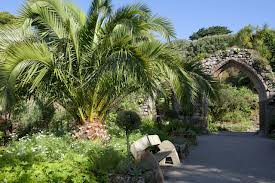
Amazing tropical gardens
Tresco Estate, Tresco, Isles of Scilly
TR24 0QQ
Tel: (01720) 422849
Email: contactus@tresco.co.uk
Web: www.tresco.co.uk
Twenty eight miles from Land's End lie the sub-tropical gardens of Tresco Abbey. Here is contained a unique collection of plants, many of which are too tender for outdoor cultivation on the mainland. Tresco Abbey Gardens flourish in the warm Gulf Stream climate and are regarded by botanists as one of the most interesting and varied horticultural experiments in the world.
They were planted by Augustus Smith, who became Lord Proprietor of the Scillies in 1834. To create the gardens, he carved terraces out of the south-facing hillside beneath his house. By 1850 they were already a place of pilgrimage.
Parts of these 17 acre gardens carry names which reflect the origin of the plants grown there: 'Higher and Lower Australia', 'Mexico' and 'South Africa Cliff' are typical. There is a strong Mediterranean and South American flavour too. Among the more spectacular sights is the tallest Norfolk Island pine in Britain in the Long Walk, bananas growing outside in the Old Abbey ruins and a very rare and prized Cordyline australis nearby in the Pebble Garden.
The winters of 1987 and 1990 saw the garden hit by unusually severe winter weather, but with the help of Kew and other botanical gardens around the world - and extensive replenishment of the damaged wind-breaks - Tresco Abbey Gardens are rapidly approaching their former glory. Meanwhile, they will continue to be the highlight of your visit to Tresco, offering hours of leisurely strolling through one of the wonders of the gardening world.
Nowhere else in the British Isles does such and exotic and exciting collection of plants grow in the open. Within its acres, palms shoot skywards; stately echiums resemble burning rockets. Agaves, aloes, proteas, bromeliads, acacias and countless plants from exotic places, which are normally grown under glass, flourish within the secure embrace of massive holm oak hedges, which protect the garden from salty gales.
From its early days Tresco has welcomed visitors; the effect is so stunning that even the non-gardener cannot fail to be impressed.
Augustus Smith chose Tresco as the site of his home because the site was more or less central in relation to the rest of the islands. It is also close to the original abbey ruins, is near a fresh water pool and overlooks the sand dunes and beach at Carn Near. The area at the time was barren land and the original building, designed by Smith and started in 1835, was small in comparison to the current building. He made additions to the house in 1843 and 1861. The Grade II listed house consists of roughly coursed granite with ashlar dressings and a slate roof. Some of the timbers from the 1861 wreck of the Award were used for the panelling and roof of the new dining room, as well as panelling of the rooms Annet, Rosevean and Rosevear. His successor, Thomas Algernon Smith-Dorrien-Smith added the tower in 1891. His descendants retain the lease into the present day.
The unique Valhalla Museum is situated within Tresco Abbey Gardens and contains a collection of some thirty figureheads, as well as name-boards and other decorative ships' carvings from the days of sail. Over the years many ships and lives have been lost on the rocky coasts of the Scillies and it is from shipwrecks - mostly of merchant vessels - that the collection was built up. A 17th-century stern decoration of the Greek god Boreas and possibly carved by Pierre Puget, is said to be from a French ship wrecked on Annet.
In 2012 five red squirrels were introduced into the Abbey Gardens. Only two survived so in 2013 the British Wildlife Centre in Surrey provided a new colony which was flown to Tresco by helicopter on a routine flight from RNAS Culdrose.
Towards the southern end of this wonderful island.
Opening TimesEvery day of the year Facilities Admission Charged |
St. Mary's St. Martin's Bryher Tresco St. Agnes The Uninhabited Islands